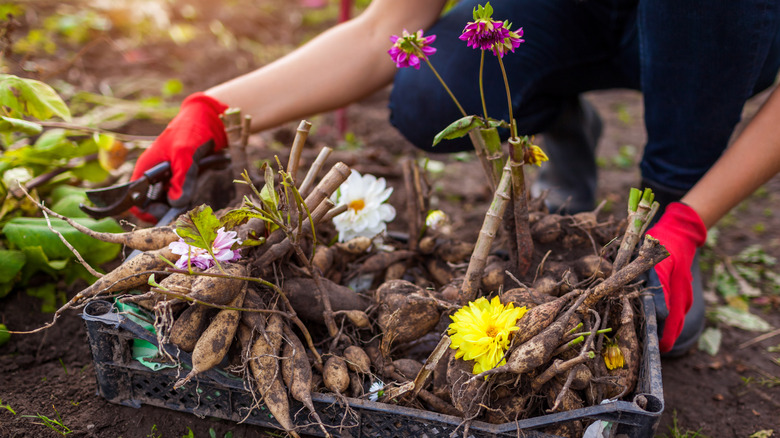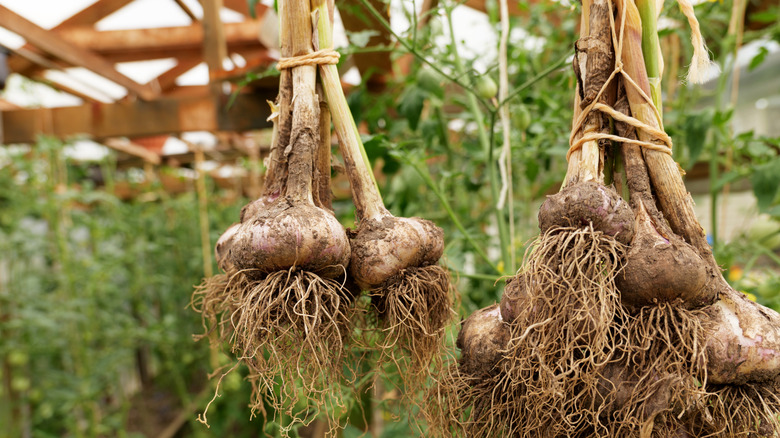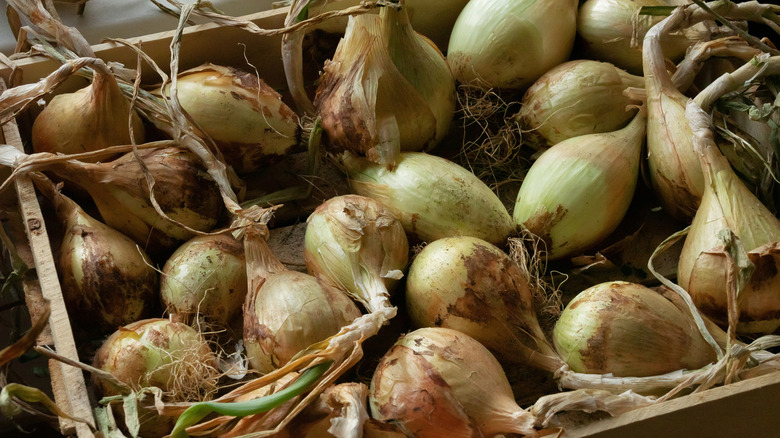10 Winter Storage Mistakes That Are Hurting Your Bulb's Chance Of Success In Spring
Tender, non-hardy bulbs with poor cold tolerance often freeze and die if left in the ground during the winter. For instance, unlike their hardy cousins like tulips and daffodils, dahlias, cannas, and gladiolus must be rescued from the ground in winter as they are cold-sensitive flowers. That is the reason why many gardeners dig up certain bulbs and store them for the next season, but if you're not careful, this is exactly where everything can go wrong. If you don't store your bulbs properly during the winter, they can rot, dry out, or decay in storage.
This can significantly impact the number of bulbs that survive and grow into healthy plants in the coming spring. Common winter storage mistakes that might be hurting your bulb's chance of success in spring include picking up your bulbs at the wrong time, skipping the curing process before putting the bulbs in storage and storing the bulbs at the wrong temperature or in moist conditions. But don't worry — all these mistakes are easy to avoid if you're looking out for them.
Digging up bulbs too early or too late before winter storage
If you want to increase your bulb's chance of success in spring, you have to dig it up in winter at the right time. Dig it up too quickly before winter storage, and it might not have enough energy reserves to sprout and grow in the coming spring. A good rule of thumb is not to dig up bulbs until the foliage has withered and yellowed. You also don't want to pick too late, as the bulb might already be frozen or dead.
Skipping the curing before putting bulbs into storage
Most bulbs, including the fastest-growing flower bulbs, need a curing or drying period before winter storage. The duration of the curing period can vary, though. For instance, caladiums, cannas, and dahlias can be cured in as few as three days before storage, whereas oxalis and gladiolus need significantly longer curing periods, about three weeks. So make sure to cure your bulbs for the proper amount of time, ideally in a dry and ventilated place at about 60 to 70 degrees Fahrenheit.
Storing bulbs at the wrong winter temperature
Winter storage temperature is another critical factor that could impact your bulb's chance of success in spring. You want to store them in a dry place with temperatures in the range of 60 to 65 degrees Fahrenheit. Don't let the temperatures exceed 70 degrees Fahrenheit, though, as it may harm the flower buds. An unfinished basement or unheated garage works great. Also, make sure to avoid any spot that might get below freezing, whether that's a freezer or an unprotected spot outdoors.
Using airtight bags or unventilated containers for storage
Another mistake that people commonly make when storing bulbs is to put them in airtight containers or sealed plastic bags. Bulbs need to breathe. Ideally, you should store them in a paper bag with holes or put them in a mesh bag. This will allow good air flow and reduce the chances of pathogen growth, decrease rot, and increase their shelf life as well.
Letting stored bulbs sit in damp, soggy conditions
When it comes to storing bulbs in winter, keeping them dry is probably the most important thing. You need to store them in a cool, dark, and dry place where moisture-loving fungus or mold is less likely to enter. For an added layer of protection, you can bury the bulbs in two to three layers of sawdust, vermiculite, or dry peat moss. Paper bags, cardboard boxes, and plastic crates are also good options.
Letting bulbs dry out and shrivel during storage
Although you want to keep your bulbs dry in storage, you don't want them to fully dry out and shrivel. Check your bulbs throughout the storage period to ensure they're still looking fresh, and if you find any dried out bulbs, throw them out. You can also try moistening the layering medium around the bulbs if the damage is not too severe. Definitely don't soak them, however — it can lead to fungal and mold growth as well as rot.
Storing bulbs with ripening/ethylene-producing fruit
While the best way to ripen green tomatoes is to put them in a paper bag with a ripening banana or apple, you don't want to store your bulbs with ripening fruit. Ripening fruits give off ethylene, which can lead to poor flowering from the bulbs in spring. It can also cause the flower bulbs to decompose more quickly than they would when stored alone.
Keeping diseased, damaged, or pest-infested bulbs in storage
When storing, take out any bulbs that may show signs of disease. It will keep the disease from spreading and prevent infection of healthy bulbs. To be extra careful, you should also take out any bulbs that are lightweight, soft or damaged. You want to inspect your bulbs thoroughly before storage and also avoid skinning, breaking, or cutting the bulbs. Diseases and pets might enter through damaged spots and lead to rotting and losses during storage.
Not labeling and organizing bulbs properly
Make sure to label any plants you store so you don't forget what's what. For this, you can write on the storage bag or directly on the bulb. Tying a tag around the bulb as an identifier is another option. Don't forget to include the cultivar name or any other important growing information in an easy-to-read spot if necessary. It's also a good idea to put more detailed growing information in a notebook or keep a separate record somewhere else to avoid losing track of your bulbs.
Exposing the bulbs to light during storage
Exposure to light is another mistake that can hurt your bulb's chance of success in spring. That is why it is recommended that you store your bulbs in a dark place during winter. This is important as darkness serves as a sign for the bulbs to enter dormancy and keeps them from germinating. A cool cupboard, an old stocking hanging under the house, or a dark spot in the garage works the best.










